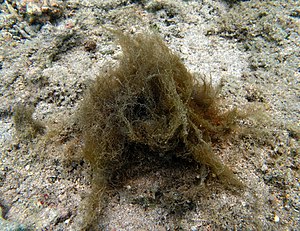Lyngbya majuscula
| Lyngbya majuscula | ||||||||||||
|---|---|---|---|---|---|---|---|---|---|---|---|---|

A Lyngbya majuscula colony in Reunion Island |
||||||||||||
| Systematics | ||||||||||||
|
||||||||||||
| Scientific name | ||||||||||||
| Lyngbya majuscula | ||||||||||||
| Harvey in Hooker ex Gomont , 1892 |
Lyngbya majuscula , also known under the English name fireweed (German "Feuertang"), is a species of marine cyanobacteria which, due to its thallous structure, is one of the seaweed species that are not systematically related. It is widespread over large parts of the tropical seas and is foundin large quantitiesin active and bleaching coral reefs as well as in protected coastal areas.
features
Lyngbya majuscula grow as yellow-, brown- or black-green to purple-black threads that can reach up to 50 centimeters in length, but usually remain shorter. The threads are not constricted on the transverse walls. The individual cells are disk-shaped, usually 35 to 45, occasionally 16 to 80 µm in diameter and 2 to 4 µm in length. They have small granules and are dull green, blue-green or gray. The terminal cells are slightly rounded. The sheath of the thread is multilayered, 4 to 11 µm thick and colorless. Lyngbya majuscula does not form heterocysts .
Initially, the species usually grows epiphytically on seagrass and can form large mats on the bottom and otherwise free-swimming mats in calm water.
Algal blooms and health consequences for humans
Lyngbya majuscula is known for its large algal blooms in which the cyanobacteria are present in large quantities. They produce a number of toxic substances that have health consequences for humans and many other animal species. The symptoms, trivially summarized as seaweed dermatitis, range from itching of the skin to redness, extensive inflammation and blistering to fever attacks and breathing difficulties.
biotechnology
More than 200 bioactive substances have been proven for the species Lyngbya majuscula , which means that it offers great potential for biotechnological uses. These uses of organisms from the sea are summarized as blue biotechnology .
The ingredients include, for example, antibiotics , anti-tumor as well as anti-inflammatory and antiviral substances that are potentially relevant for the manufacture of pharmaceuticals . Intensive research is carried out for the recovery of fungus-inhibiting and cell-toxic ingredients, including Laxaphycin A and B and curacin A . As early as 1977, debromoaplysia toxin , which is effective against leukemia, was obtained from Lyngbya majuscula and the closely related L. gracilis .
The dimers of the bioactive substances malyngolide and tanicolide , which can be extracted from Lyngbya majuscala, are good inhibitors of the human SIRT2 protein. They could therefore be used as a cancer drug.
Evidence cited
- ↑ Espinel Nadjejda:Lyngbya majuscula Harvey in Hooker ex Gomont, 1892. MarineSpecies.org
- ↑ a b Fireweed Fears Hosed Down ( Memento of the original from March 10, 2007 in the Internet Archive ) Info: The archive link was inserted automatically and has not yet been checked. Please check the original and archive link according to the instructions and then remove this notice. , The University of Queensland
- ↑ Species description at the Smithsonian Tropical Research Institute
- ↑ AM Burja, E. Abou-Mansour, B. Banaigs, C. Payri, JG Burgess & PC Wright: Culture of the marine cyanobacterium, Lyngbya majuscula (Oscillatoriaceae), for bioprocess intensified production of cyclic and linear lipopeptides. Journal of Microbiological Methods 48 (2-3), 2002; Pages 207-219. ( Abstract ( Memento of the original from March 26th, 2009 in the Internet Archive ) Info: The archive link has been inserted automatically and has not yet been checked. Please check the original and archive link according to the instructions and then remove this note.
- ↑ Jon S. Mynderse, Richard E. Moore, Midori Kashiwagi and Ted R. Norton: Antileukemia Activity in the Oscillatoriaceae: Isolation of Debromoaplysiatoxin from Lyngbya. Science, New Series, Vol. 196, No. 4289 (April 29, 1977); Pages 538-540. ( Abstract )
- ^ A b Jean-Michel Kornprobst: Encyclopedia of Marine Natural Products . Wiley-VCH Verlag GmbH & Co. KGaA, Weinheim, Germany 2014, ISBN 978-3-527-33585-5 , p. 156 , doi : 10.1002 / 9783527335855 ( wiley.com [accessed June 11, 2019]).
Web links
- Taxonomy: http://www.uniprot.org/taxonomy/158786
literature
- Andrew Watkinson: Ecophysiology of the marine cyanobacterium, Lyngbya majuscula (Oscillatoriacea). Thesis submitted to the Department of Botany, University of Queensland, for the partial fulfillment of Bachelor of Science (Hons), 2000. ( Full text ; PDF; 360 kB)
- Moreton Bay Waterways and Catchments Partnership: Lyngbya Management Strategy. Queensland Government 2002. ( full text )